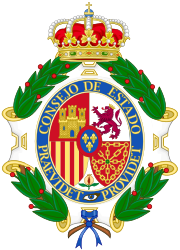
Spain, or the Kingdom of Spain, is a country located in Southwestern Europe, with parts of its territory in the Atlantic Ocean, the Mediterranean Sea and Africa. It is the largest country in Southern Europe and the fourth-most populous European Union member state. Spanning across the majority of the Iberian Peninsula, its territory also includes the Canary Islands in the Atlantic Ocean, the Balearic Islands in the Mediterranean Sea, and the autonomous cities of Ceuta and Melilla in Africa. Peninsular Spain is bordered to the north by France, Andorra, and the Bay of Biscay; to the east and south by the Mediterranean Sea and Gibraltar; and to the west by Portugal and the Atlantic Ocean. Spain's capital and largest city is Madrid, and other major urban areas include Barcelona, Valencia, Zaragoza, Seville, Málaga, Murcia, Palma de Mallorca, Las Palmas de Gran Canaria, and Bilbao.

The politics of the Netherlands take place within the framework of a parliamentary representative democracy. A constitutional monarchy, the country is organised as a decentralised unitary state. The Netherlands can be described as a consociational state. Dutch politics and governance are characterised by a common striving for broad consensus on important issues, within both of the political community and society as a whole.

The monarchy of Spain or Spanish monarchy is the constitutional form of government of Spain. It consists of a hereditary monarch that reigns as the head of state, being the highest office of the country. The current King is Felipe VI since 19 June 2014, after the abdication of his father, King Juan Carlos I.
In a parliamentary or semi-presidential system of government, a reserve power, also known as discretionary power, is a power that may be exercised by the head of state without the approval of another branch or part of the government. Unlike in a presidential system of government, the head of state is generally constrained by the cabinet or the legislature in a parliamentary system, and most reserve powers are usable only in certain exceptional circumstances.

The prime minister of Spain, officially president of the Government, is the head of government of Spain. The prime minister chairs the Council of Ministers and nominates its ministers; in these sense, the prime minister establishes the Government policies and coordinates the actions of the Cabinet members. As chief executive, the prime minister also advises the monarch on the exercise of their royal prerogatives.
A constitutional convention is an informal and uncodified tradition that is followed by the institutions of a state. In some states, notably those Commonwealth of Nations states that follow the Westminster system and whose political systems derive from British constitutional law, most government functions are guided by constitutional convention rather than by a formal written constitution. In these states, actual distribution of power may be markedly different from those the formal constitutional documents describe. In particular, the formal constitution often confers wide discretionary powers on the head of state that, in practice, are used only on the advice of the head of government, and in some cases not at all.

The Spanish Constitution is the supreme law of the Kingdom of Spain. It was enacted after its approval in a constitutional referendum; it represents the culmination of the Spanish transition to democracy. It is a written constitution.

The Cortes Generales are the bicameral legislative chambers of Spain, consisting of the Congress of Deputies and the Senate.

The Council of Ministers is the main collective decision-making body of the Government of Spain, and it is exclusively composed of the Prime Minister, the deputy prime ministers and the ministers. Junior or deputy ministers such as the Secretaries of State are not members of the Council. The Monarch may also chair the Council when needed on the invitation of the Prime Minister.
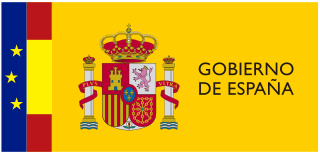
The government of Spain is the central government which leads the executive branch and the General State Administration of the Kingdom of Spain.

The Iberian Union is a historiographical term used to describe the dynastic union of the Monarchy of Spain, which in turn was itself a dynastic union of the crowns of Castile and Aragon, and the Kingdom of Portugal, and of their respective colonial empires, that existed between 1580 and 1640 and brought the entire Iberian Peninsula except Andorra, as well as Portuguese and Spanish overseas possessions, under the Spanish Habsburg monarchs Philip II, Philip III, and Philip IV. The union began after the Portuguese crisis of succession and the ensuing War of the Portuguese Succession, and lasted until the Portuguese Restoration War, during which the House of Braganza was established as Portugal's new ruling dynasty with the acclamation of John IV as the new King of Portugal.
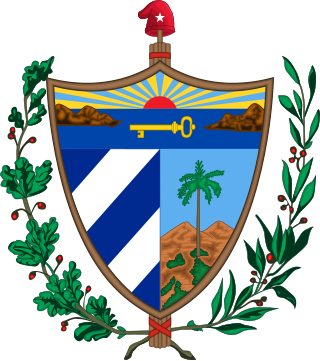
The Council of Ministers, also referred to as simply the Cabinet of Cuba, is the highest ranking executive and administrative body of the Republic of Cuba, and constitutes the nation's government. It consists of the President, the First Vice President and the five Vice Presidents of the Council of State, the Secretary of the Executive Committee, the heads of the national ministries, and other members as established by law.
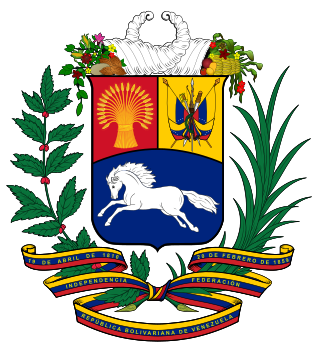
The Cabinet of Ministers of Venezuela (Spanish: Gabinete de Ministros de Venezuela is one of the bodies that make up the Venezuelan executive in that country's presidential system, alongside the Council of Ministers. The Cabinet is headed by the president of Venezuela, and his corresponding vice president. The purpose of the ministries is to create, adopt, follow and evaluate policies, strategies, programs and projects in accordance with the constitution and the laws of the republic.

The Council of the Indies, officially the Royal and Supreme Council of the Indies, was the most important administrative organ of the Spanish Empire for the Americas and those territories it governed, such as the Spanish East Indies. The crown held absolute power over the Indies and the Council of the Indies was the administrative and advisory body for those overseas realms. It was established in 1524 by Charles V to administer "the Indies", Spain's name for its territories. Such an administrative entity, on the conciliar model of the Council of Castile, was created following the Spanish conquest of the Aztec empire in 1521, which demonstrated the importance of the Americas. Originally an itinerary council that followed Charles V, it was subsequently established as an autonomous body with legislative, executive and judicial functions by Philip II of Spain and placed in Madrid in 1561.

The Constitution of Uruguay is the supreme law of Uruguay. Its first version was written in 1830 and its last amendment was made in 2004.
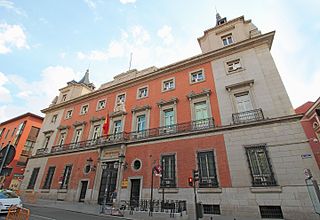
The Ministry of Justice (MJUS) was the department of the Government of Spain responsible for preparing and carrying out the government policy in order to bring the legal system off, specially in criminal, civil, commercial and procedural law affairs, supporting the Administration of Justice and the legal and international cooperation.
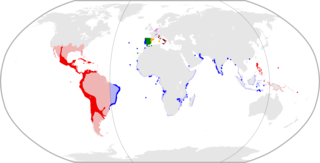
The Council of Aragon, officially, the Royal and Supreme Council of Aragon, was a ruling body and key part of the domestic government of the Spanish Empire in Europe, second only to the monarch himself. It administered the Crown of Aragon, which was composed of the Kingdom of Aragon, Principality of Catalonia, Kingdom of Valencia, Kingdom of Mallorca, and finally the Kingdom of Sardinia. The Aragonese possessions in Southern Italy were later incorporated into the Council of Italy, together with the Duchy of Milan, in 1556. The Council of Aragon ruled these territories as a part of Spain, and later the Iberian Union.

The Ministry of Defence (MINISDEF) is the department of the Government of Spain responsible for planning, developing and carrying out the general guidelines of the Government about the defence policy and the managing of the military administration. It is the administrative and executive body of the Spanish Armed Forces.

The Polysynodial System, Polysynodial Regime or System of Councils was the way of organization of the composite monarchy ruled by the Catholic Monarchs and the Spanish Habsburgs, which entrusted the central administration in a group of collegiate bodies (councils) already existing or created ex novo. Most of the councils were formed by lawyers trained in academic study of Roman law. After its creation in 1521, the Council of State, chaired by the monarch and formed by the high nobility and clergy, became the supreme body of the monarchy. The polysynodial system met its demise in the early 18th century in the wake of the promulgation of the Nueva Planta decrees by the incoming Bourbon dynasty, which organized a system underpinned by Secretaries of State.
The Secretary of State or Secretary of State and of the Office was the title given in Spain to the King's ministers during the Ancient Regime of Spain, between the 17th century and the mid-19th century, when it was definitively replaced by the term "minister". It should be clarified that the Secretaries of State and of the Office of State, i.e. the heads of the Secretariat in charge of foreign affairs, were commonly known as Secretaries of State and, although they had the same rank as the other Secretaries of the Office, the Secretary of State assumed the leading role, presiding over the meetings of the ministers and attending to the most important matters.
